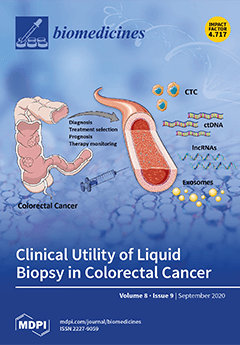Open AccessArticle
Polygenic Markers in Patients Diagnosed of Autosomal Dominant Hypercholesterolemia in Catalonia: Distribution of Weighted LDL-c-Raising SNP Scores and Refinement of Variant Selection
by
Jesús M. Martín-Campos, Sheila Ruiz-Nogales, Daiana Ibarretxe, Emilio Ortega, Elisabet Sánchez-Pujol, Meritxell Royuela-Juncadella, Àlex Vila, Carolina Guerrero, Alberto Zamora, Cristina Soler i Ferrer, Juan Antonio Arroyo, Gemma Carreras, Susana Martínez-Figueroa, Rosa Roig, Núria Plana, Francisco Blanco-Vaca and Xarxa d’Unitats de Lípids i Arteriosclerosi (XULA)
Cited by 6 | Viewed by 2580
Abstract
Familial hypercholesterolemia (FH) is associated with mutations in the low-density lipoprotein (LDL) receptor (
LDLR), apolipoprotein B (
APOB), and proprotein convertase subtilisin/kexin 9 (
PCSK9) genes. A pathological variant has not been identified in 30–70% of clinically diagnosed FH
[...] Read more.
Familial hypercholesterolemia (FH) is associated with mutations in the low-density lipoprotein (LDL) receptor (
LDLR), apolipoprotein B (
APOB), and proprotein convertase subtilisin/kexin 9 (
PCSK9) genes. A pathological variant has not been identified in 30–70% of clinically diagnosed FH patients, and a burden of LDL cholesterol (LDL-c)-raising alleles has been hypothesized as a potential cause of hypercholesterolemia in these patients. Our aim was to study the distribution of weighted LDL-c-raising single-nucleotide polymorphism (SNP) scores (weighted gene scores or wGS) in a population recruited in a clinical setting in Catalonia. The study included 670 consecutive patients with a clinical diagnosis of FH and a prior genetic study involving 250 mutation-positive (FH/M+) and 420 mutation-negative (FH/M−) patients. Three wGSs based on LDL-c-raising variants were calculated to evaluate their distribution among FH patients and compared with 503 European samples from the 1000 Genomes Project. The FH/M− patients had significantly higher wGSs than the FH/M+ and control populations, with sensitivities ranging from 42% to 47%. A wGS based only on the SNPs significantly associated with FH (wGS8) showed a higher area under the receiver operating characteristic curve, and higher diagnostic specificity and sensitivity, with 46.4% of the subjects in the top quartile. wGS8 would allow for the assignment of a genetic cause to 66.4% of the patients if those with polygenic FH are added to the 37.3% of patients with monogenic FH. Our data indicate that a score based on 8 SNPs and the75th percentile cutoff point may identify patients with polygenic FH in Catalonia, although with limited diagnostic sensitivity and specificity.
Full article
►▼
Show Figures






